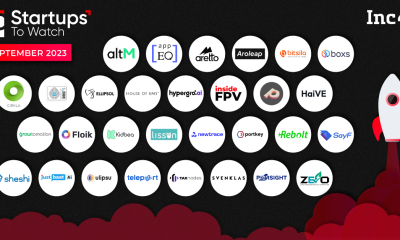Portable solar generators are so useful that you increasingly see them at the beach, campground, job site, or anywhere without access to grid power. But they’re also an expensive luxury if shoved into storage as soon as you return home.
Science
EcoFlow’s $200 PowerStream is so clever, you might buy a $4,000 solar generator

EcoFlow’s $200-ish PowerStream box can help maximize the year-round usefulness of the company’s own solar generators. It’s pitched as a plug-in “balcony solar system” that anyone can install, even if you’re renting an apartment.
These DIY systems from EcoFlow, Anker, and others became very popular around Europe over the last few years as energy costs soared amid steadily decreasing solar and battery prices. They can lower your energy bills and ensure a modicum of home backup in the event of a power outage.
Plug-in systems are built around a microinverter that feeds solar energy back into the home via a standard wall jack. The solar panels can be leaned up against a terrace wall, placed in a garden, or hung off a balcony railing. Any solar excess not used immediately by the home can be diverted into the solar generator’s big-ass battery for use later.
I’ve been testing an EcoFlow PowerStream setup in my own home, where I’ve installed $1,500 worth of EcoFlow’s portable solar panels on my roof, with the cables snaking through a window to the PowerStream box connected to a $2,599 EcoFlow Delta Pro. I also have six EcoFlow smart plugs attached to things like the washing machine, coffee maker, and home theater projector that tell the PowerStream to send more or less power.
It’s surprisingly simple to set up and get running, but not without some initial trepidation about safety, which I delve into below. I also made a mistake that killed the first PowerStream EcoFlow sent me. But importantly, I learned a lot about my family’s energy consumption habits and how much power 800W of haphazardly installed solar panels can produce under a weak northern sun.
So, it’s a shame that EcoFlow’s PowerStream is a Europe-only solution for now.
How does it save me money?
The PowerStream has three proprietary ports: one that connects to your MC4 solar panels; one that connects to your battery; and one AC output that plugs into a standard wall socket. The battery is entirely optional if you just want to feed every watt of solar power produced back into your home.
To understand how the PowerStream works, let’s look at a real example using screen recordings taken from the excellent EcoFlow app. Note how the direction of power delivery changes from GIF to GIF as EcoFlow’s smart plugs steadily increase demand.
In the first GIF above, I’m generating 397W of solar power, but my home is only demanding 290W — 250W for the “base load” and 40W for EcoFlow’s smart plugs (both of which I’ll describe in detail later). Since that load could be covered by solar power alone, the PowerStream didn’t need to request any power from the grid. It immediately sends the excess 107W of solar to charge the connected Delta Pro battery instead.
But after I turn on my home theater projector, the “smart plug” load jumps to 239W, and my solar panels can no longer cover the 489W now demanded by my home. So PowerStream diverts an extra 92W from the battery to cover the new total. Power grid demand is still 0W since the incoming solar power and battery power can cover the total demand of the home.
Finally, I turn on my Nespresso coffee machine, which activates the grid. The PowerStream has a maximum output of 800W (805W in this example), so it pulls an extra 845W from my grid provider to cover the 1,650W (1.4K plus 250W) my home is now demanding.
And while batteries do degrade if you cycle them every day like this, the LFP chemistry used by modern solar generators like the Delta Pro should maintain 80 percent of its charging capacity after 3,500 cycles — that’s almost 10 years. And it should still be good for 50 percent capacity after 6,000 cycles.
By the end of my example day, the PowerStream had produced a total of 3.03kWh, saving me a grand total of… 90 euro cents at my current energy rates. That might not sound like a lot, but at that rate, it will easily pay off the PowerStream after about a year of usage — faster in some climates and slower in others. Notably, it would have paid itself off in just months last year, when I was paying over three times as much per kWh due to global events.
Importantly, I have gained a degree of energy independence in this uncertain world — and making regular use of an expensive solar generator that was otherwise just waiting for the next road trip or natural disaster.
Great, but is feeding that much electricity into a standard wall socket actually safe?
A power outlet becomes a power inlet
It might seem odd and even unsafe to feed electricity into something called a power outlet, but AC wall jacks are, in fact, bidirectional under the right conditions.
The PowerStream is a mini power plant that automatically synchronizes with the grid to ensure seamless integration with the devices plugged into your home circuitry. Power flows from high to low voltages, which is why the grid voltage is slightly higher (by millivolts) than the devices plugged in. The PowerStream similarly alters its voltage to regulate the flow of power to your devices.
EcoFlow says that PowerStream is not a burden on 16A home circuits in Europe because it’s limited to a maximum of 800W (or 600W in Germany, currently) and requires less than 3.5A. PowerStream has obtained grid certification in over 10 countries, covering 70 percent of Europe. You might still have to register it with your local energy provider, however — so do check your local requirements.
And when there’s a power outage, the PowerStream will turn off automatically to ensure there’s no electricity in the wires in order to protect line workers from shock. The PowerStream will only turn back on when the grid power returns.
(This also means that the PowerStream, unlike a Tesla Powerwall or EcoFlow’s own Delta Pro Ultra home backup system, can’t automatically switch over to battery during a blackout to power the home. Instead you have to disconnect the battery — a 100-pound Delta Pro in my case — from the PowerSteam and wheel it to wherever power is needed, like the kitchen or basement.)
Despite how it looks in the app, the PowerStream isn’t actually sending power directly to the devices attached to those EcoFlow smart plugs. The PowerStream uses the smart plugs as signals to pump more or less juice into the stream of power entering the home, from which every device can drink.
Microinverters like EcoFlow’s PowerStream aren’t available in the US at all due to restrictions that prohibit plug-in grid solutions.
Installation
The hardest part in setting up the PowerStream is doing the math to ensure your solar panels are wired up properly in series or parallel, especially when maxing out the system like I did. My bad math caused me to smoke the first PowerStream review unit by overvolting it (where, by “smoke,” I mean it just stopped working forever). Eventually, I figured out the right wiring configuration to keep everything under the 55V / 13A limit of the PowerStream’s solar inputs.
My setup is meant to be temporary because I still want to take the portable EcoFlow solar panels and Delta Pro on the road — but those panels need to be securely mounted. This can be done using EcoFlow’s own mounts (or your own, like I did) because a strong wind could easily send those lightweight panels flying. Of course, there’s nothing preventing you from connecting a PowerStream to rigid panels from any company you choose.
EcoFlow also sells its PowerStream with a new waterproof battery for a super tidy outdoor installation. Everything, including the PowerStream, is IP54 rated, and the 2kWh battery is even heated to ensure proper operation in temperatures down to -20 degrees Celsius (-4 degrees Fahrenheit). The kit runs completely silently, as does the PowerStream in my own comparatively crude installation.
With all the hardware installed, you then need to decide whether to prioritize power delivery from the PowerStream to your home circuitry or to battery storage. I currently default to home but would switch that to battery if a storm were in the forecast to ensure I had backup power. While you can schedule these modes to change throughout the day, you can only do it based on time, which is a shame. Ideally, it would automatically prioritize the battery if a big storm were in the forecast, as many home backup systems do.
Still, scheduling a change in priority modes can be very useful if you’re on a variable energy contract. That way, you can charge the battery during off-peak hours and then use that relatively cheap stored energy to power the home when electricity prices are highest.
1/8
The real trick to optimizing the PowerStream is to first determine your home’s idle baseline power usage — how many watts your home continuously pulls before turning on things like the dishwasher or coffee maker. Mine’s about 300W, according to the display on the smart energy meter in my utility closet. Ideally, EcoFlow’s PowerStream would get real-time readings from my smart meter, but that’s not currently possible.
So, I set what EcoFlow calls the base load to 250W in its app to ensure a 50W cushion. That way, I can avoid feeding energy back into the grid. Doing so has potential financial repercussions depending on your provider and where you live. As the sun returns here in the Netherlands, power companies are struggling to cope with oversupply under the current solar incentive scheme, resulting in charges levied against panel owners for energy returned to the grid.
EcoFlow smart plugs help direct traffic
Some PowerStream installations will benefit from a handful of Matter-enabled EcoFlow smart plugs installed on high-consumption devices like the TV, washer, dryer, dishwasher, refrigerator, and boiler to properly balance the load. They tell the PowerStream that those devices are demanding even more power than the base load, so it needs to ramp things up. Each smart plug costs €36 (about $39).
In the first screen recording below, you can see the PowerStream delivering 482W into the home. It determines this number by starting with the 250W I set as my base load and adding 232W to cover all the devices connected to the smart plugs. And since only 355W was coming in via solar at the time, it pulls an additional 127W from the connected Delta Pro battery for the home. In the second recording, the excess solar power is immediately diverted to the battery now that the projector is turned off.
And while the app shows the power grid delivering 0W into the home, this is pure fantasy since I don’t have smart plugs on every single device attached to my home. (And remember, my true baseline is closer to 300W.)
More power-heavy homes can just skip the smart plugs entirely. My maxed-out system with 800W of solar input can only generate a maximum of 4kWh per day, usually much less. That’s not enough to cover my daily base load of 6kWh (250W x 24 hours). So I should just feed enough solar power into the home to cover my base load during the day and send any excess to the EcoFlow battery for use when the sun goes down.
I have to say, I’m incredibly impressed by the PowerStream, especially now that it’s priced at just €150, almost half off the €279 it cost at launch last year. Not only does it help existing owners of EcoFlow’s solar generators maximize the value for their money but it also makes the idea of owning a solar generator more tempting knowing you can use it year-round, at home or off the grid.
It also makes the owner acutely aware of their energy habits. I’ve been obsessing over the EcoFlow app’s data like a new runner who just bought their first Garmin watch. For me, it’s been an interesting and relatively frugal first step toward energy independence. I now have real data and experience to help make a very complex decision about installing my own fixed panel system.
Photography by Thomas Ricker / The Verge
Science
NASA wants SpaceX and Blue Origin to deliver cargo to the moon

The agency wants Elon Musk’s SpaceX to use its Starship cargo lander to deliver a pressurized rover to the Moon “no earlier” than 2032, while Jeff Bezos’ Blue Origin will be tasked with delivering a lunar surface habitat no sooner than 2033. Both launches will support NASA’s Artemis missions, which aim to bring humans back to the Moon for the first time in over 50 years.
Both companies are developing human landing systems for Artemis missions — SpaceX for Artemis III and Blue Origin for Artemis V. NASA later asked both companies to develop cargo-hauling variants of those landers, capable of carrying 26,000 to 33,000 pounds of equipment and other materials to the Moon.
NASA says it will issue proposals to SpaceX and Blue Origin at the beginning of next year.
“Having two lunar lander providers with different approaches for crew and cargo landing capability provides mission flexibility while ensuring a regular cadence of Moon landings for continued discovery and scientific opportunity,” Stephen D. Creech, NASA’s assistant deputy associate administrator for the Moon to Mars program, said in the announcement.
Science
Brazil leads new international effort against climate lies

Brazil and the United Nations launched a new international effort to combat disinformation on climate change. They announced the Global Initiative for Information Integrity on Climate Change during the G20 Leaders’ Summit taking place in Rio de Janeiro, Brazil.
It’s a collaboration between governments and international organizations to boost research on misinformation swirling online and around the globe that they fear could slow action on climate change. There isn’t much information available yet, but they say they’ll fund nonprofit efforts to counter that spread of lies.
“Countries cannot tackle this problem individually,” President of Brazil Luiz Inácio Lula da Silva said in a press release.
“Countries cannot tackle this problem individually.”
Only Chile, Denmark, France, Morocco, the United Kingdom, and Sweden have joined Brazil in the initiative so far. Countries that make the commitment are expected to contribute to a fund administered by the United Nations Educational, Scientific and Cultural Organization (UNESCO). The initial goal is to get more countries on board and raise $10 to 15 million over the next three years. The money is then supposed to be distributed to nonprofit organizations as grants to support research and public awareness campaigns on climate disinformation.
They haven’t yet named any specific groups they plan to work with; “calls for partnerships” are forthcoming. Some environmental organizations are already working together to study disinformation and push for measures to stop its spread, like the Climate Action Against Disinformation coalition that publishes reports on misinformation trends and advocates for more stringent content moderation.
A webpage for the new global initiative says environmental disinformation is “increasingly spreading through social media, messaging apps, and generative AI.” That has “serious” consequences, it says: “it undermines scientific consensus, obstructs authorities’ ability to respond effectively to the crisis, and threatens the safety of journalists and environmental defenders working on the frontlines.”
FEMA employees faced violent threats on social media in the aftermath of Hurricane Helene in the US, for example. Accounts spewing misinformation about the storm and FEMA were also tied to content denying climate change, according to an analysis by the Institute for Strategic Dialogue (ISD) in October. Posts baselessly accused FEMA of seizing private property and confiscating donations — lies that risked deterring storm survivors from applying for assistance, and that raised fears that FEMA staff might face attacks.
United Nations Secretary-General António Guterres also voiced his concerns during remarks today with both the G20 summit and a UN conference on climate change currently underway. “We must also take on climate disinformation,” Guterres said. “Our climate is at a breaking point.”
Science
Amazon and SpaceX attack US labor watchdog in court

Amazon and SpaceX are seeking to hamstring the National Labor Relations Board, asking a court to declare its processes for upholding labor law unconstitutional. But judges on a three-person panel appeared skeptical when the companies presented their arguments Monday.
In two separate cases before the Fifth Circuit Court of Appeals, the two companies argued that the NLRB is unlawfully forcing them to participate in administrative law proceedings over alleged anti-labor actions. The Amazon case centers around whether it’s required to bargain with the union at its JFK 8 fulfillment center on Staten Island, while the SpaceX case involves a charge by former employees who claimed they were fired after being critical of CEO Elon Musk.
A ruling in favor of the companies could undermine the NLRB’s power to enforce protections for workers. It comes just as vocal pro-union President Joe Biden is leaving office and deregulation-friendly President-elect Donald Trump takes over. Trump notably counts Musk among his chief allies after his massive fundraising push. The NLRB is an independent agency with five board members appointed by the president to 5-year terms.
During oral arguments, the judges mostly prodded attorneys on the finer points of the companies’ decisions to appeal, and the timeline of their objections. At one point, Judge James Graves Jr., an Obama appointee, expressed doubt that Amazon had even met the conditions for an appeal — suggesting it should have waited on the ruling from the district court first. Two days after Amazon’s notice of appeal, the district court denied Amazon’s request for a temporary restraining order on its NLRB proceedings.
Both companies are seeking to short-circuit the NLRB’s proceedings with a court order
George W. Bush-appointed Judge Priscilla Richman similarly pressed SpaceX’s counsel Michael Kenneally about why the company rushed to an appeal, rather than letting the case progress in a lower court. Kenneally said SpaceX waited as long as it felt it could to bring its challenge and accused the government of leaning on procedural arguments because it couldn’t defend the NLRB’s constitutionality. Graves appeared skeptical. “That sounds to me about like the argument that, ‘well, procedure doesn’t matter if I win on the merits, so just skip right over procedure,’” he said.
Both companies are seeking to short-circuit the NLRB’s proceedings with a court order, which requires demonstrating this would cause them irreparable harm. But in Amazon’s case, NLRB counsel Tyler Wiese called the company’s deadline for the district court “imaginary,” and said, “merely proceeding through an administrative process is not irreparable harm.”
Amazon and SpaceX both argue that the NLRB’s administrative proceedings are tainted because its board members or administrative law judges are unconstitutionally insulated from removal. They point to Article II of the Constitution, which says the president must “take care that the Laws be faithfully executed,” which they say includes removing officials.
Amazon also says the NLRB is violating the Seventh Amendment, which protects the right to a jury trial in certain civil cases. It argues that the NLRB shouldn’t be allowed to decide on financial remedies related to the case because it would deny the company due process. Cox said the board itself “improperly interfered with the [union] election by exercising its prosecutorial authority,” so failing to stop the proceedings would let the NLRB as as judge and prosecutor.
The NLRB says it feels confident in a 1937 Supreme Court ruling on the constitutionality of the National Labor Relations Act. “It is nothing new for big companies to challenge the authority of the NLRB to enforce workers’ rights so as not to be held accountable for their violations of the National Labor Relations Act,” NLRB General Counsel Jennifer Abruzzo said in a statement. “While the current challenges require the NLRB to expend scarce resources defending against them, we’ve seen that the results of these kinds of challenges is ultimately a delay in justice, but that ultimately justice does prevail.”
-

 Startup Stories1 year ago
Startup Stories1 year agoWhy Millennials, GenZs Are Riding The Investment Tech Wave In India
-

 Startup Stories1 year ago
Startup Stories1 year agoStartups That Caught Our Eyes In September 2023
-

 Startup Stories1 year ago
Startup Stories1 year agoHow Raaho Is Using Tech To Transform India’s Fragmented Commercial Trucking
-

 Startup Stories1 year ago
Startup Stories1 year agoMeet The 10 Indian Startup Gems In The Indian Jewellery Industry’s Crown
-

 Crptocurrency9 months ago
Crptocurrency9 months agoLither is Making Crypto Safe, Fun, and Profitable for Everyone!
-

 Startup Stories1 year ago
Startup Stories1 year agoHow Volt Money Is Unlocking The Value Of Mutual Funds With Secured Lending
-

 E-commerce1 year ago
E-commerce1 year agoTop Online Couponing Trends To Watch Out For In 2016
-

 Startup Stories1 year ago
Startup Stories1 year agoWhy Moscow-Based Kladana Considers Indian SME Sector As The Next Big Market For Cloud Computing




